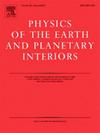Three-dimensional magnetotelluric inversion with structurally guided regularization constraint
IF 2.4
3区 地球科学
Q2 GEOCHEMISTRY & GEOPHYSICS
引用次数: 0
Abstract
We propose a novel technique for the structurally regularized three-dimensional magnetotelluric inversion scheme. In the proposed method, the structural resemblance between the inverted electrical resistivity model and the independently derived guiding model is enforced by controlling the weights of the roughness operator for regularization. Using a simple mathematical function, we forced the weights to be small across presumed discontinuities in the guiding model, allowing for sharp changes in resistivity values across the discontinuity. We forced the weights to be large along blocks with similar values in guiding physical parameters, enforcing smooth changes of resistivity along the blocks. Numerical inversion tests indicate that the new guided inversion produces a resistivity model that closely approximates the true model, surpassing the results of both conventional smooth inversion and cross-gradient inversion, particularly when a perfectly correlated guiding model is used. We applied our guided inversion method to magnetotelluric data in Southern Tohoku, Northeast Japan, with structural constraints from a seismic velocity structure. Given the non-uniqueness problem of MT inversion, guided inversion enables the exploration of alternative resistivity structures that are more consistent with geological or geophysical models than those produced by conventional smooth inversion, therefore expanding the possibility of interpretation. We suggest that the proposed inversion method can serve as an alternative to the commonly used cross-gradient method, especially in the absence of objective schemes for the simultaneous selection of multiple trade-off parameters in the objective function.

构造导向正则化约束的大地电磁三维反演
提出了一种构造正则化三维大地电磁反演方法。在该方法中,通过控制粗糙度算子的权值进行正则化,使反演电阻率模型与独立导出的导向模型在结构上具有相似性。使用一个简单的数学函数,我们强制在指导模型中假定的不连续面上的权重较小,从而允许在不连续面上电阻率值的急剧变化。在引导物性参数时,我们迫使权值在相近的块体上较大,从而使电阻率沿块体平滑变化。数值反演试验表明,该方法得到的电阻率模型与真实模型非常接近,优于常规光滑反演和交叉梯度反演的结果,特别是在采用完全相关的导向模型时。我们将引导反演方法应用于日本东北东北南部的大地电磁资料,并考虑了地震速度结构的结构约束。考虑到大地电磁法反演的非唯一性问题,与常规光滑反演相比,制导反演可以探测到与地质或地球物理模型更一致的交替电阻率结构,从而扩大了解释的可能性。我们认为,所提出的反演方法可以作为常用的交叉梯度法的替代方法,特别是在缺乏目标函数中多个权衡参数同时选择的客观方案时。
本文章由计算机程序翻译,如有差异,请以英文原文为准。
求助全文
约1分钟内获得全文
求助全文
来源期刊

Physics of the Earth and Planetary Interiors
地学天文-地球化学与地球物理
CiteScore
5.00
自引率
4.30%
发文量
78
审稿时长
18.5 weeks
期刊介绍:
Launched in 1968 to fill the need for an international journal in the field of planetary physics, geodesy and geophysics, Physics of the Earth and Planetary Interiors has now grown to become important reading matter for all geophysicists. It is the only journal to be entirely devoted to the physical and chemical processes of planetary interiors.
Original research papers, review articles, short communications and book reviews are all published on a regular basis; and from time to time special issues of the journal are devoted to the publication of the proceedings of symposia and congresses which the editors feel will be of particular interest to the reader.
 求助内容:
求助内容: 应助结果提醒方式:
应助结果提醒方式:


